Hey readers, welcome to the Color Parade! Let’s take a joyful stroll down a lane where art meets tradition, stitches meet stories, and colors shout louder than your neighbor’s wedding DJ. We’re talking about the Applique Work of Pipili—Odisha’s iconic craft that once decorated temples and now struts confidently down global fashion runways (yes, even in Paris and Milan!).
Born in a small town near Puri, this vibrant fabric art is over 850 years old and was originally made for Lord Jagannath’s grand Rath Yatra. Fast forward to today, and Pipili’s bold patterns and patchwork pieces are lighting up everything from tote bags to tunics, from cushion covers to couture dresses.
According to recent stats, Pipili’s applique exports have grown by over 30% in the last five years, proving that what was once made for gods is now trending with the gods of fashion.
So sit back, smile, and let’s unravel the colorful tale of how Pipili’s humble stitches took over the world—one patch at a time!
Where It All Began: The Birthplace of Pipili Appliqué
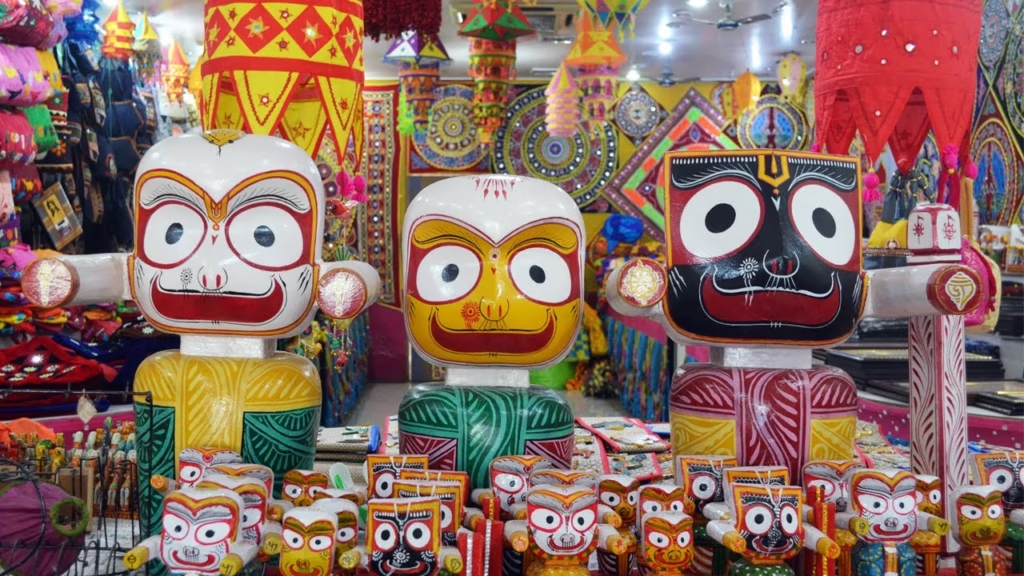
Before fashion weeks, runway lights, and Pinterest mood boards, there was a tiny town in Odisha called Pipili—the OG influencer of appliqué craft! Nestled just 20 km from Bhubaneswar, this little town has been stitching stories for centuries, quite literally. If embroidery had a royal cousin in India, it would be Pipili appliqué—bold, colorful, and with a flair for the dramatic (move over, drama queens).
This isn’t your everyday needlework; it’s art with attitude, born to dazzle the gods and now lighting up homes, runways, and even international decor catalogs. Pipili’s legacy proves one thing: when tradition meets talent, even a humble village can shine like a handcrafted superstar.
Linked to Lord Jagannath: Why Temples Wore Appliqué First
Way before it hit the markets, Pipili appliqué was already a divine trendsetter. The first “clients”? Lord Jagannath and his siblings! These vivid fabric pieces were designed as ceremonial coverings, chariots’ canopies, and flags for the grand Rath Yatra in Puri.
Here’s why temples loved it:
- Easy to make in large, colorful patterns.
- Strong enough to handle Odisha’s unpredictable weather.
- Rich in spiritual symbolism, with motifs like sun, moon, and mythical animals.
Who knew the gods had such good taste?
More than Decoration: Appliqué as Spiritual Offering
In Pipili, appliqué wasn’t just stitched for style—it was stitched with faith. Artisans believed every thread carried a prayer, and every pattern was a form of devotion.
What made it more than just decoration?
- Crafted specifically for rituals and festivals.
- Designs were based on spiritual stories and divine blessings.
- Often offered as gifts to gods, not just customers.
It was less “Do you like this cushion cover?” and more “Here’s a handmade love letter to the universe.”
What Makes Pipili Appliqué So Unique?
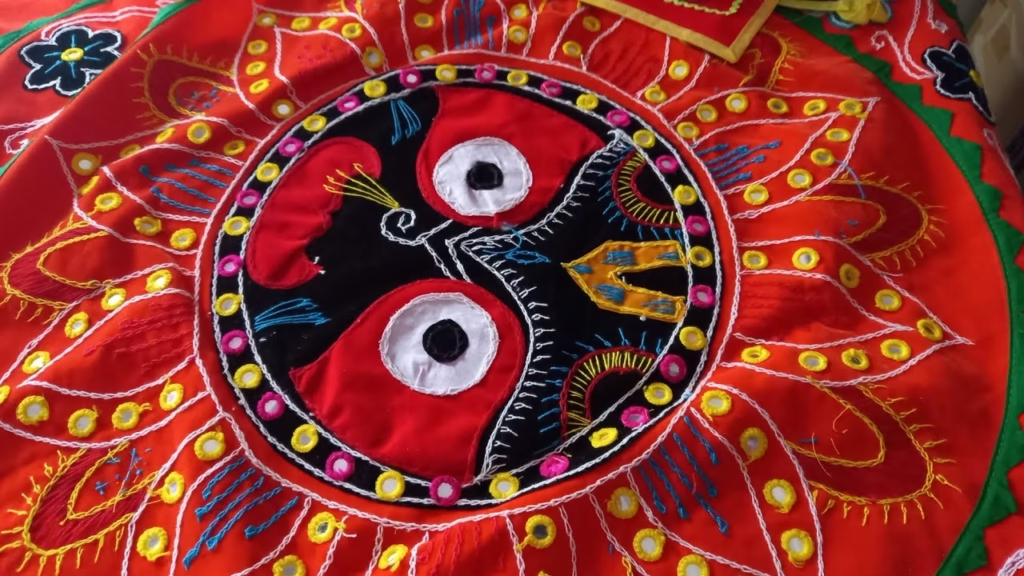
Welcome to the land of color explosions, dancing threads, and fabric that practically throws a party for your eyes! Pipili Appliqué from Odisha is not just embroidery—it’s a full-blown celebration stitched onto cloth. Imagine if a rainbow went shopping at a handicraft fair—that’s Pipili for you.
What started centuries ago to decorate temples during Rath Yatras now jazzes up homes, weddings, and even Instagram feeds. With over 600 families in Pipili town keeping this art alive, it’s not just fabric—it’s a family legacy, a cultural vibe, and an unapologetic burst of joy. So let’s break down what makes Pipili Appliqué so special—it’s not just stitches; it’s soul with sparkle.
Color Riot on Cloth: The Signature Look
Pipili Appliqué doesn’t whisper—it shouts with color! Bright reds, sunny yellows, peppy pinks, and electric blues are stitched onto dark or contrasting backdrops, making every piece a visual treat. This color clash isn’t accidental—it’s designed to stand out in festivals, parades, and life’s happiest moments.
- Bright cotton or velvet cloth is used as the base
- Bold contrast colors make the design pop
- Often used to make umbrellas, wall hangings, bags, canopies, and cushion covers
Traditional Motifs: Elephants, Peacocks, and Palanquins
One of the most special things about the appliqué work of Pipili is the beautiful motifs used in every design. These are not just decorations—they are like little stories stitched into the fabric. Inspired by Odisha’s temple culture, festivals, and royal traditions, each motif has a meaning that adds life to the art.
Here are some of the most popular and loved motifs:
- Elephants with decorated trunks – These grand animals stand for good luck, strength, and royalty. In many designs, they wear fancy headgear and look ready for a royal parade!
- Peacocks with fancy feathers – Peacocks bring the charm! They stand for beauty, grace, and joyful dancing. Their colorful shapes add a lively feel to the fabric.
- Palanquins and flower patterns – These remind us of weddings and happy celebrations. They show the joy and tradition of Indian ceremonies.
The motifs used in Applique Work of Pipili make every piece look rich, colorful, and full of meaning—just like a festival in fabric form!
Handmade Magic: Stitch by Stitch, Soul by Soul
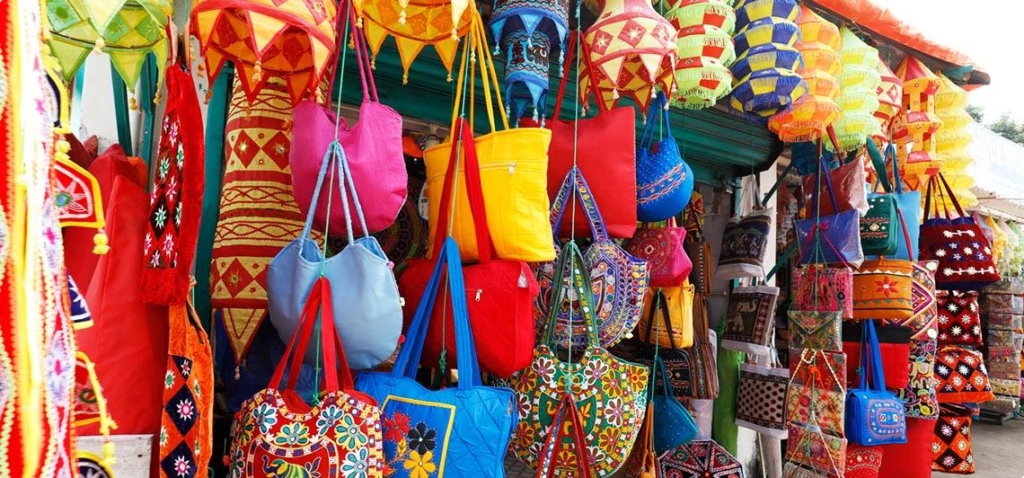
The beauty of the appliqué work of Pipili lies not just in its colors and patterns, but in the loving hands that create it. Every single piece is handmade with care, patience, and heart. There are no big machines or factory shortcuts here—just skilled artisans, mostly women, who have learned this art from their mothers and grandmothers, just like passing down a secret family recipe.
Here’s what makes it truly special:
- Every stitch is done by hand, layer by layer. From cutting the fabric shapes to placing them just right, it’s all about skill and steady hands.
- No two pieces are exactly alike. Each design has a unique charm, because it’s made by a human, not a machine.
- It can take hours, or even days, to complete one item, whether it’s a wall hanging, umbrella, bag, or lantern.
The Applique Work of Pipili may not walk red carpets like movie stars, but it definitely shines in its own way. It’s a true fashion icon—full of culture, color, and handmade love!
From Streets to Shrines: How It Shaped Local Culture
What do glowing canopies, swaying chariots, and colorful wedding flags have in common? Nope, it’s not a circus—it’s the vibrant, handcrafted magic that lights up Odisha’s roads, rituals, and even rooftops! From humble lanes to holy temples, local crafts like Pipili applique work have become symbols of celebration, devotion, and good old-fashioned glam. Whether it’s a temple festival or a Tuesday market, Odisha knows how to dress to impress!
But this isn’t just about pretty cloth and stitching skills—it’s about identity, culture, and stories told with a needle. Crafts like Pipili and puppetry forms like Tholu Bommalata remind us that traditional art is not something you hang on a wall and forget.
It walks with us, winks at us from wedding mandaps, and sometimes even flies above us on temple flags. Ready to explore how these colorful threads and shadows stitch themselves into every part of Odia life? Let’s unravel the magic, one applique at a time!
Canopies, Chariots, and Ceremonial Flags
The streets of Odisha aren’t just busy—they’re dressed for the occasion! From Puri’s Rath Yatra to village festivals, colorful Pipili appliqué canopies and chariot covers aren’t just decorations; they’re spiritual armor.
- Used on Lord Jagannath’s chariots, these cloth designs are blessed before use.
- Flags fluttering on temple spires are often crafted in Pipili villages.
- Even tiny roadside shrines flaunt vibrant covers like they are walking the red carpet!
These pieces aren’t stitched randomly. Every sun, flower, and peacock has meaning—a silent prayer sewn into fabric.
Pipili on Every Phera: Weddings, Fairs, and Festivals
Planning a wedding in Odisha? Better book your Pipili crafts before your caterer.
- Wedding mandaps are decked with bold Pipili pieces.
- Fairgrounds showcase rows of applique wall hangings and umbrellas.
- Festivals like Makar Sankranti and Durga Puja use them in pandals and parades.
These designs aren’t shy. They shine, shimmer, and say, “We’re here to party!”
More Than Just Cloth: A Symbol of Odia Pride
The applique work of Pipili is not just a craft—it’s a symbol of Odisha’s rich culture, tradition, and pride. Each stitch carries the soul of a place where art is not only made but lived. For the people of Pipili, this isn’t just cloth and thread—it’s their identity, their legacy, and their love for their land.
Here’s why this craft is truly special and treasured:
- Odisha exports over ₹10 crore worth of Pipili appliqué items every year. From cushion covers to decorative umbrellas, these handcrafted pieces travel from small village workshops to homes across the world.
- It’s officially registered under the Geographical Indication (GI) tag. This means it’s recognized as a unique craft that can only come from Pipili, ensuring its authenticity and protecting the artisans’ hard work.
- Tourists and locals proudly buy it as a cultural keepsake. Whether it’s a small wall hanging or a large temple canopy, each piece carries the story of Odisha’s vibrant heritage.
Pipili appliqué is an art that not only speaks—it shines with meaning.
The Global Glow-Up: Pipili on Fashion Week Ramps
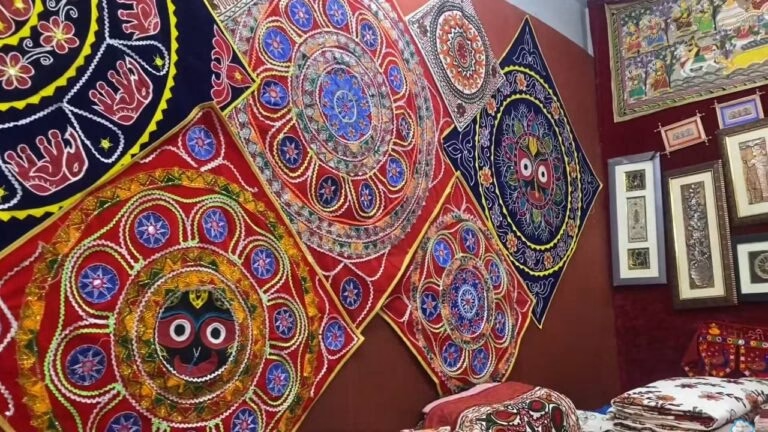
Move over glitter, Odisha’s got game! What once fluttered proudly on temple roofs and Rath Yatra chariots has now strutted its way to the world’s swankiest ramps. Yes, we are talking about the vibrant appliqué craft of Pipili! Once only seen in the narrow lanes near Puri, it’s now dazzling crowds in Milan, Paris, and even at New York Fashion Week. From being soaked in culture to soaking in the spotlight, Pipili has had a major wardrobe glow-up.
Let’s unravel how Odisha’s patchwork wonder made it from temple tops to fashion tops. Spoiler alert: there’s sparkle, stardust, and some serious stitching skills involved.
From Temple Roofs to Paris Runways: How Did This Happen?
Yes, it sounds unbelievable—but it’s true! The applique work of Pipili, which once decorated temple rooftops and the grand chariots of Odisha’s famous Rath Yatra, is now strutting down international fashion runways. This vibrant craft, with roots in the 12th century, has found a new stage—and it’s a global one!
Here’s how Pipili made that incredible leap from temples to trendbooks:
- Indian designers began exploring and reimagining traditional crafts. They saw beauty in heritage and started using Pipili’s bold motifs in modern silhouettes, from jackets to handbags.
- The rise of sustainable and handmade fashion gave Pipili a fresh spotlight. With the world turning towards eco-friendly clothing, this slow, hand-stitched art became a perfect fit.
- Fashion brands were on the lookout for unique, colorful, and handmade elements. Pipili’s vibrant patterns and rich history gave them just the right blend of tradition and drama.
- Social media platforms like Instagram brought global attention. Designers, tourists, and influencers began showcasing Pipili pieces—turning local craft into international fashion buzz.
From temples to trendsetters—Pipili’s journey is nothing short of fabulous!
Designers Who Fell in Love with Pipili
When it comes to Indian fashion, some designers don’t just follow trends, they make them. And guess what? The Applique Work of Pipili has completely stolen their hearts! Big names like Sabyasachi Mukherjee, Anita Dongre, and Rahul Mishra have added a splash of Pipili magic to their collections. They’ve taken this traditional Odia art and given it a global, glamorous twist, without losing its handmade charm.
Here’s how they’re showing their love for Pipili on the runway:
- Statement jackets with large appliqué peacock motifs: These regal birds aren’t just beautiful—they carry elegance, pride, and tradition stitched into every feather.
- Sarees with Pipili-inspired sun, moon, and floral designs: These motifs bring cosmic vibes and temple culture into everyday fashion, making each drape a story.
- Modern accessories like capes, sling bags, clutches, and even sneakers: Odisha’s vibrant art now walks not just on ramps, but also on streets, fashion-forward and heritage-rich!
With Pipili, designers aren’t just creating outfits; they are crafting wearable stories. Now that’s couture with culture!
Celebs, Couture, and a Touch of Odisha
When stars sparkle, so does tradition—and the Applique Work of Pipili is getting its much-deserved red-carpet moment! Bollywood fashion queens like Vidya Balan, Sonam Kapoor, and even some international influencers have proudly flaunted Pipili-inspired looks, bringing Odisha’s age-old craft into the limelight. These handcrafted pieces are no longer just part of temple rituals—they’re part of high fashion now.
Here’s how Pipili is lighting up the celeb scene:
- Paparazzi flashes now capture Odisha pride: Be it at film festivals, airport looks, or event launches, celebs draped in Pipili motifs are giving the cameras a real reason to click.
- Pipili bags and clutches spotted at Cannes and Met Gala: Yup, those bold patterns and vibrant stitches are making waves on global red carpets—and turning heads, too!
- Reels and posts by fashion influencers using Pipili jackets, capes, or even cushion props: Instagram has a new favorite aesthetic—and it’s stitched with tradition!
Tech Meets Tradition: Modern Twists on an Ancient Craft
Once upon a time in Pipili, Odisha, Appliqué Work was mostly seen fluttering on chariots during festivals. Fast forward to today, and—surprise!—those same vibrant stitches are strutting down fashion runways and popping up in Instagram reels. That’s right, the Appliqué Work of Pipili has gone full glow-up mode!
Thanks to tech-savvy artisans and design nerds, this centuries-old art isn’t just surviving—it’s slaying. From Adobe Illustrator to AI-based embroidery machines, tradition is now vibing with innovation. Over 60% of young artisans in Pipili are now using smartphones to market their designs on platforms like Etsy and Instagram. One viral reel, and boom—orders from Delhi to Denmark!
Who said culture can’t trend? Today’s Pipili designs are not only dressing gods but also dressing up Gen Z. Whether it’s a laptop sleeve or a lehenga, the blend of traditional craft and modern style is giving people serious “I want that!” energy.
Let’s dive into how the ancient thread is weaving into our modern lives.
Young Artisans Going Digital
The youth of Pipili are proving that tech and tradition can go hand in hand (or thumb in touchscreen).
- Many are using Canva and Photoshop to design custom appliqué patterns.
- Some run full-fledged e-stores on platforms like Amazon and Flipkart.
- Tutorials and behind-the-scenes videos are trending on YouTube and Instagram.
This new wave is not just about creativity—it’s also boosting the local economy. According to recent reports, digitally active artisans saw a 40% increase in sales in the last 2 years.
Appliqué Bags, Lamps, Jackets & Home Décor
The appliqué work of Pipili is no longer something you just hang on a wall or see during a festival—it has stepped into everyday life in the most vibrant and stylish way. This traditional Odia art has found its place in homes, wardrobes, and even workspaces, becoming a colorful part of modern living. From cozy corners to fashion-forward streets, Pipili’s magic is everywhere.
Check out how this ancient craft is showing off in today’s world:
- Tote bags with large appliqué designs of temple elephants and peacocks: These aren’t just bags—they are bold fashion statements that carry culture with every step.
- Jackets stitched with colorful appliqué motifs: Perfect for streetwear lovers who want to add a splash of handmade tradition to their urban look.
- Lampshades glowing with festive appliqué work: Whether it’s a cozy room or a party setting, these lights bring a touch of Odia celebration.
- Cushion covers decorated with stories from Indian mythology: They don’t just support your back—they spark conversations!
It’s not just craft anymore. It’s a lifestyle upgrade with roots!
Fusion Styles: Streetwear Meets Sacred Art
Who would’ve imagined that Odisha’s sacred Pipili appliqué art—once reserved for temple rituals and rath yatras—would be vibing on the same wavelength as hip-hop beats and Gen Z fashion? But that’s exactly what’s happening! Traditional art is getting a cool, contemporary remix, blending divine motifs with street-smart edge. It’s folk meets funk, and the results are jaw-dropping.
Here’s how the new fashion wave is rocking it:
- Oversized hoodies featuring fierce appliqué lions, sun motifs, and chakra designs: A perfect combo of boldness and blessings, turning heads on city streets.
- Sneakers stitched with traditional Pipili mirror work and vivid fabrics: These kicks aren’t just for walking—they’re strutting centuries of culture with every step.
- Festival jackets that blend temple architecture patterns with neon graffiti elements: They bring ancient stories to modern music festivals with unapologetic swag.
In this trend, Pipili isn’t just stitched—it’s styled. Sacred art just dropped a fashion mixtape, and yes, it’s straight fire.
Final Takeaway
Pipili’s appliqué work is not just for temples anymore. It is now seen on clothes, bags, lamps, and even in fashion shows! This colorful art from Odisha is full of life and beauty. It shows how old traditions can become part of our modern lives.
What started in temples many years ago is now loved by people all over the world. Designers, celebrities, and even tourists enjoy Pipili’s bright and beautiful style. Every design tells a story—about gods, nature, or culture.
Pipili is not just a place—it is now a fashion trend. When you carry a Pipili bag or wear a Pipili jacket, you are also carrying a part of Odisha’s history and heart.
So, next time you see a colorful patchwork elephant or a sun stitched on cloth, smile and say, “That’s Pipili!”—a small town doing big things with art.
Visit our Traditional Art Blog to read them all in a simple, fun way.

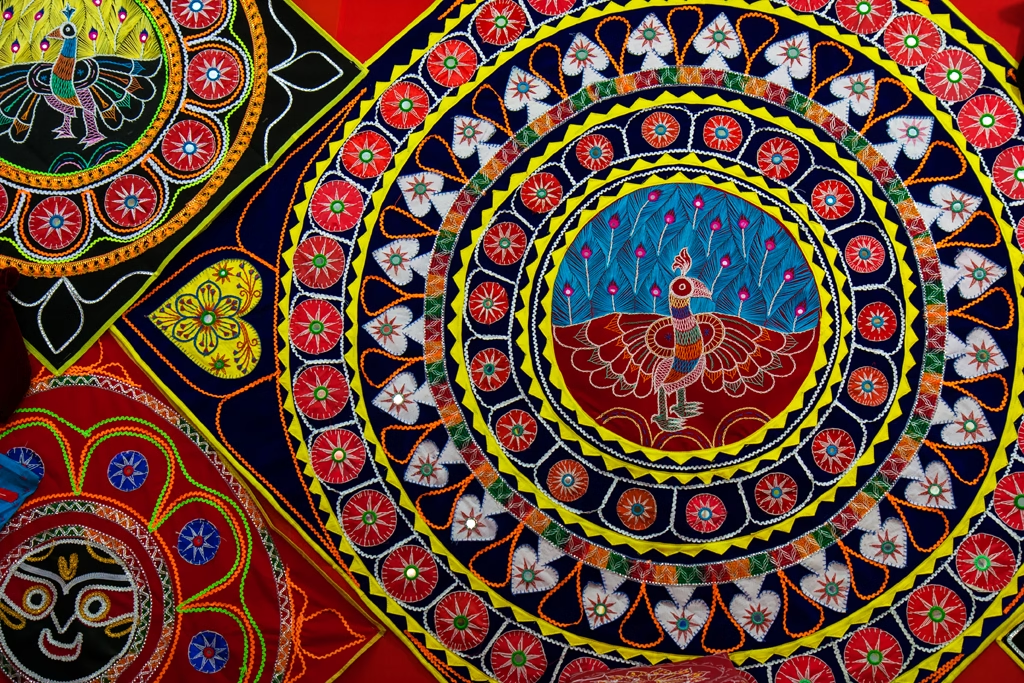
Leave a Reply